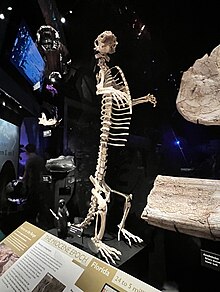Enhydritherium
| Enhydritherium Temporal range:
| |
|---|---|

| |
| E. terraenovae skeleton at Florida Museum of Natural History. | |
| Scientific classification | |
| Domain: | Eukaryota |
| Kingdom: | Animalia |
| Phylum: | Chordata |
| Class: | Mammalia |
| Order: | Carnivora |
| Family: | Mustelidae |
| Subfamily: | Lutrinae |
| Genus: | †Enhydritherium Berta and Morgan 1985 |
| Species: | †E. terraenovae
|
| Binomial name | |
| †Enhydritherium terraenovae Berta and Morgan 1985
| |
Enhydritherium terraenovae is an extinct marine
million years.The ancestral lineage of Enhydritherium terraenova can be traced to Africa and Eurasia, but no clear route of migration can be determined according to Thompson et al.[2]
Taxonomy
Enhydritherium terraenovae was named by Berta and Morgan in 1985[3] and is the genotype for this animal. Its type locality is the phosphate Palmetto Mine in Florida, which is in a Hemphillian marginal marine sandstone in the Upper Bone Valley Formation of Florida.
Fossil distribution
Fossil specimens were found in California (3 sites) and Florida (8 sites).
In 2017, part of a jawbone was found in the Juchipila Basin, Zacatecas.[4] Located about 200 km from the modern Pacific coast and 600 from the Gulf of Mexico, the finding suggests the animal migrated across the continent using fresh water corridors in central Mexico.[5]
References
- ^ Alroy, John, PaleoDB collection 19461: authorized by J. Alroy, entered by J. Alroy on August 5, 1996. paleodb.org
- ISBN 0-8018-7416-5
- JSTOR 1304931.
- ^ "Rare Otter Fossil Found in the Mexican Desert". 14 June 2017. Archived from the original on June 15, 2017. Retrieved 9 June 2018.
- PMID 28615353.
